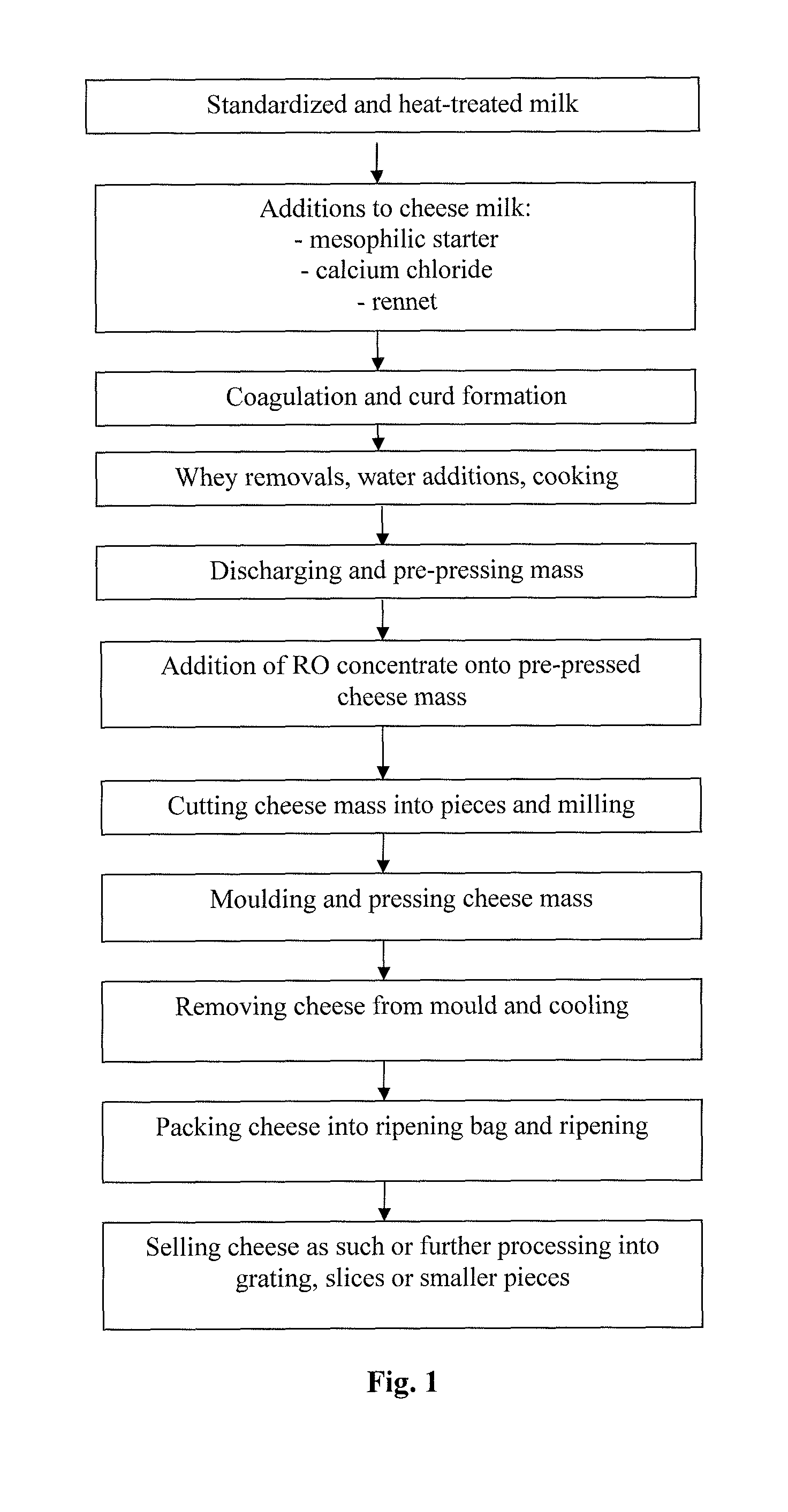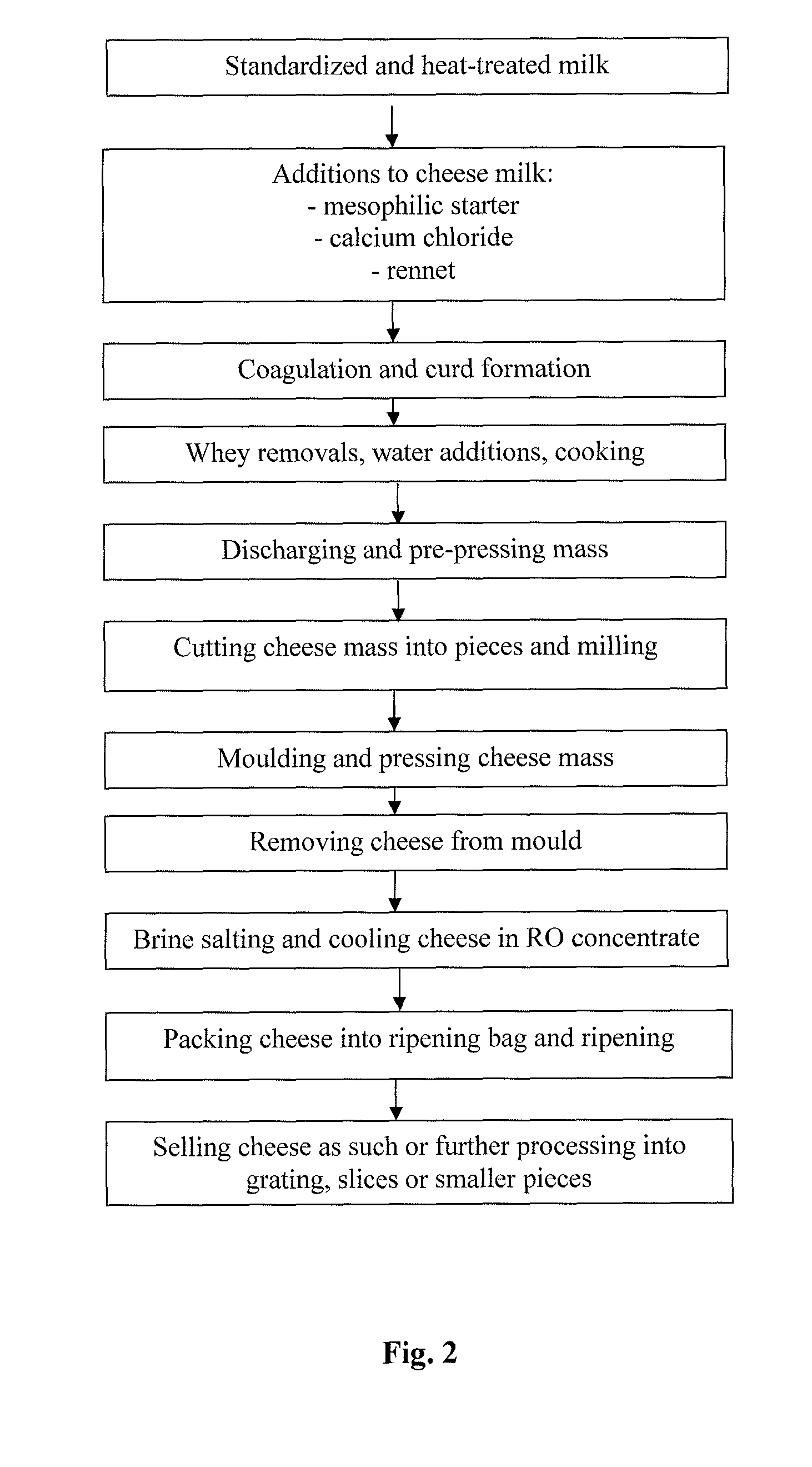Cheese and method for its manufacturing
a technology of cheese and raw materials, applied in the field of cheesemaking techniques, can solve the problems of high risk of disease, bitterness and acidity of products, and low salt content of products, and achieve the effects of improving taste and other organoleptic properties, retaining and/or maintaining organoleptic properties, and eliminating and/or covering taste defects and/or off-tastes
- Summary
- Abstract
- Description
- Claims
- Application Information
AI Technical Summary
Benefits of technology
Problems solved by technology
Method used
Image
Examples
example 1
[0097]FIG. 1 is a flow diagram showing steps of a cheesemaking process. It describes a method for making salt-free milled ripened cheese, wherein milk- or whey-based minerals (RO concentrate described above) are added to a pre-pressed mass.
[0098]A milled cheese containing 15% of fat (such as Turunmaa® 15%) was salted in the pre-pressing step with milk- or whey-based minerals (RO retentate), which were added in an amount of 1 to 2% of the cheese weight calculated on the basis of ash content. The bulk starter in the vat was a normal mixed starter (such as CHN-19 by Chr Hansen) in an amount of 0.8 to 1.0% calculated on the basis of milk amount and, alternatively, a thermophilic shocked T101 starter (Valio Oy) in an amount of 0.4% calculated on the basis of milk amount. Alternatively, it is also possible to use a thermophilic non-shocked Lb161 starter (Valio Oy) (0.5 to 1% calculated on the basis of milk amount). In addition to the bulk starter, additional starters LH-32, BS-10, CR-312 ...
example 2
[0110]FIG. 2 is a flow diagram showing steps of a cheesemaking process. It describes a method for making salt-free milled ripened Turunmaa® cheese with a fat content of 15%, wherein the cheese is salted by brine salting in whey minerals (RO concentrate).
[0111]The cheese of the invention was made as in Example 1 except that the cheese was salted by brine salting in an RO concentrate. CHN-19 starter by Chr Hansen in an amount of 1% calculated on the basis of milk amount was used as a bulk starter in the vat. Essential steps after pre-pressing the cheese mass included cutting and milling the cheese mass, moulding and pressing the cheese mass, removing the cheese from the mould, after which the cheese was brine salted and cooled in the RO concentrate for 2 to 6 hours, packed into ripening bags, ripened for 8 weeks and possibly post-processed as in Example 1. The sodium content of the finished cheese was 0.06 to 0.12% calculated on the basis of cheese amount.
[0112]The taste of the cheese...
example 3
[0113]The production steps of the low-salt, round-eyed cheese (Polar® 15%) of the invention correspond to those of FIG. 2 except that the steps of discharging and pre-pressing the mass as well as cutting and milling the cheese mass were replaced by a Casomatic distributor, where the cheese mass (curd) was conveyed directly into moulds and pressed, after which the cheese was brine salted and cooled in an RO concentrate for 2 to 6 hours, packed into ripening bags, ripened and possibly post-processed as in Example 1.
[0114]Alternatively, a salt-free round-eyed Polar® 10% was made by producing the cheese curd by the Coagulator technique as a partly continuous process.
[0115]Alternatively the low-salt ripened cheese was granular (Oltermanni®).
PUM
 Login to view more
Login to view more Abstract
Description
Claims
Application Information
 Login to view more
Login to view more - R&D Engineer
- R&D Manager
- IP Professional
- Industry Leading Data Capabilities
- Powerful AI technology
- Patent DNA Extraction
Browse by: Latest US Patents, China's latest patents, Technical Efficacy Thesaurus, Application Domain, Technology Topic.
© 2024 PatSnap. All rights reserved.Legal|Privacy policy|Modern Slavery Act Transparency Statement|Sitemap



